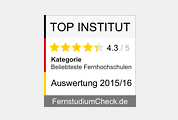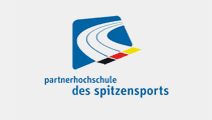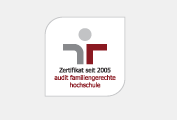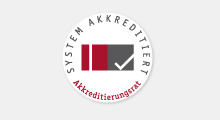Please note: For any information regarding the master seminar organized by the Softech chair, please
click here.
Seminar Software-Engineering
The SEDA chair offers the joint software engineering seminar for bachelor and master students during the 2017 summer semester.
The goal of the seminar is the introduction into scientific methods including the critical reading, understanding, summarizing and presentation of published scientific papers.
Seminar topics are from the software engineering domain with a focus on
SEDA chair
- Systems Engineering for Cyber-Physical Systems
- Safety, Security, Reliability and Availability
- Risk-Assessment and -Minimization
- Model-Based Safety Analysis
Registration
Die deadline for registration is 2017-03-03.
Due to the high number of attendees, topics will only be available to registered students.
Since the number of registrations already exceeds the number of available topics, free slots will be assigned randomly.
In order to register for the seminar, please send us a short
email with the following information.
- name
- course of studies
- bachelor oder master
- which software engineering lectures did you attend
- preference SEDA or Softech
Topics
Note: Clicking on a topic in the list below will open a more detailed view.
T1 (Bachelor/Master): Integrating vehicle collaboration concepts to AUTomotive Open System Architecture (AUTOSAR)
|
Description |
Cooperative vehicles are no longer fiction. A key factor is the ability for vehicles to exchange information with their environment. Shared information has the potential to increase safety and efficiency of vehicle systems. Such collaboration concepts, however, have to be considered for current standards like AUTOSAR to enable a broad application. This seminar paper shall elaborate a related work analysis on the topic.
|
|
Literature |
-
Östberg, Kenneth, and Magnus Bengtsson. "Run time safety analysis for automotive systems in an open and adaptive environment." SAFECOMP 2013-Workshop ASCoMS (Architecting Safety in Collaborative Mobile Systems) of the 32nd International Conference on Computer Safety, Reliability and Security. 2013.
-
Rushby, John. "Kernels for safety." Safe and Secure Computing Systems (1989): 210-220.
-
Schneider, D.; Trapp, M., "A Safety Engineering Framework for Open Adaptive Systems," Self-Adaptive and Self-Organizing Systems (SASO), 2011 Fifth IEEE International Conference on , vol., no., pp.89,98, 3-7 Oct. 2011 doi: 10.1109/SASO.2011.20
-
Östberg, Kenneth, et al. "Intelligent transport systems-The role of a safety loop for holistic safety management." International Conference on Computer Safety, Reliability, and Security. Springer International Publishing, 2014.
|
|
Supervisor |
Sebastian Müller
|
T2 (Bachelor/Master): Combination of Safety and Security Analysis
|
Description |
In most cases in a safety analysis the influences of security problems are omitted or even forgotten. Because more and more systems are accessible from the outside of the system via maintenance interfaces, this missing security analysis is becoming a problem. New approaches for a combined assessement of safety and security should solve this problem. This seminar paper shall elaborate a related work analysis on the topic.
|
|
Literature |
-
M. Steiner, P. Liggesmeyer, "Combination of Safety and Security Analysis - Finding Security Problems That Threaten The Safety of a System", in SAFECOMP 2013 - Workshop DECS (ERCIM/EWICS Workshop on Dependable Embedded and Cyber-physical Systems) of the 32nd International Conference on Computer Safety, Reliability and Security, M. ROY, Ed.
-
M. Steiner, P. Liggesmeyer, "Qualitative and Quantitative Analysis of CFTs Taking Security Causes into Account", in Computer Safety, Reliability, and Security, F. Koornneef, C. van Gulijk, Eds., Springer International Publishing, 2015, pp. 109-120.
-
Fovino, Igor Nai, Marcelo Masera, and Alessio De Cian. "Integrating cyber attacks within fault trees." Reliability Engineering & System Safety 94.9 (2009): 1394-1402.
-
Mauw, Sjouke, and Martijn Oostdijk. "Foundations of attack trees." International Conference on Information Security and Cryptology. Springer Berlin Heidelberg, 2005.
|
|
Supervisor |
Sebastian Müller
|
T3 (Bachelor/Master): The Role of Situation Awareness in Assuring Safety of Autonomous Vehicles
|
Description |
Assuring safety of autonomous vehicles operating in an open environment requires reliable situation awareness, action planning and prediction of actions of other vehicles and objects. Factors that also have to be considered are certainty and completeness of available information and trust in information sources and other entities. This seminar paper shall elaborate a related work analysis on the topic.
|
|
Literature |
-
Wardziński, Andrzej. "The role of situation awareness in assuring safety of autonomous vehicles." International Conference on Computer Safety, Reliability, and Security. Springer Berlin Heidelberg, 2006.
-
Huang, Yu-Hsing, et al. "Accident models for modern road traffic: changing times creates new demands." Systems, Man and Cybernetics, 2004 IEEE International Conference on. Vol. 1. IEEE, 2004.
-
Ozguner, Umit, Christoph Stiller, and Keith Redmill. "Systems for safety and autonomous behavior in cars: The DARPA Grand Challenge experience." Proceedings of the IEEE 95.2 (2007): 397-412.
|
|
Supervisor |
Sebastian Müller
|
T4 (Bachelor): Design Challenges of Cyber-Physical Systems
|
Description |
Cyber-Physical Systems (CPS) are integrations of computation (software) with physical processes (hardware). Many of these applications are safety-critical since their failure can cause damage and injuries to the environment. The goal of this works is to give an overview of key characteristics as well as current challenges when designing Cyber-Physical Systems.
|
|
Literature |
-
Rajkumar, Ragunathan Raj, et al. "Cyber-physical systems: the next computing revolution." Proceedings of the 47th Design Automation Conference. ACM, 2010.
-
L. Sha, S. Gopalakrishnan, X. Liu and Q. Wang, "Cyber-Physical Systems: A New Frontier," 2008 IEEE International Conference on Sensor Networks, Ubiquitous, and Trustworthy Computing (sutc 2008), Taichung, 2008, pp. 1-9. doi: 10.1109/SUTC.2008.85
-
E. A. Lee, "Cyber Physical Systems: Design Challenges," 2008 11th IEEE International Symposium on Object and Component-Oriented Real-Time Distributed Computing (ISORC), Orlando, FL, 2008, pp. 363-369. doi: 10.1109/ISORC.2008.25
|
|
Supervisor |
Felix Möhrle
|
T5 (Bachelor/Master): Classification of Safety Analysis Methods
|
Description |
There exist a variety of methodologies for safety analysis, such as Failure Modes and Effects Analysis (FMEA), Fault Tree Analysis (FTA), Hazard and Operability Studies (HAZOP) and many more. The goal of this work is to give an overview of the most popular methodologies and to create a classification scheme, highlighting key advantages and disadvantages of each class.
|
|
Literature |
-
Wang, J., and T. Ruxton. "A review of Safety analysis methods applied to the design process." Journal of Engineering Design 8.2 (1997): 131-152.
-
Fenelon, Peter, et al. "Towards integrated safety analysis and design." ACM SIGAPP Applied Computing Review 2.1 (1994): 21-32.
-
Domis, Dominik, and Mario Trapp. "Integrating safety analyses and component-based design." International Conference on Computer Safety, Reliability, and Security. Springer Berlin Heidelberg, 2008.
|
|
Supervisor |
Felix Möhrle
|
T6 (Bachelor/Master): Extensions of Fault Tree Analysis
|
Description |
Fault tree analysis (FTA) is a popular safety analysis technique that is widely accepted in the industry. Many extensions to classic fault trees exist that introduce new gates to model complex types of failure logic. The goal of this work is to give an overview of some of these extensions and highlight their key additions.
|
|
Literature |
-
Vesely, William E., et al. Fault tree handbook. No. NUREG-0492. Nuclear Regulatory Commission Washington DC, 1981.
-
Kaiser, Bernhard, Peter Liggesmeyer, and Oliver Mäckel. "A new component concept for fault trees." Proceedings of the 8th Australian workshop on Safety critical systems and software-Volume 33. Australian Computer Society, Inc., 2003.
-
Walker, Martin, Leonardo Bottaci, and Yiannis Papadopoulos. "Compositional temporal fault tree analysis." International Conference on Computer Safety, Reliability, and Security. Springer Berlin Heidelberg, 2007.
|
|
Supervisor |
Felix Möhrle
|
T7 (Bachelor/Master): Safety Challenges of Self-Adaptive Systems
|
Description |
Self-Adaptive systems possess dynamic behavior that allows the system to reconfigure and adapt according to the changes in the environment or the system itself. If operated in safety-critical environment, the necessity for safety assurance becomes evident. This seminar paper should explain various aspects of safety assurance for such systems using (but not limited to) the related work.
|
|
Literature |
-
Runtime Safety Models in open Systems of Systems – D. Schneider and M. Trapp
-
Software Engineering for Self-Adaptive Systems: A Research Roadmap – B. H. C. Cheng, R. Lemos, H. Giese, P. Inverardi and J. Magee
-
A Safety-Case Approach For Certifying Adaptive Systems – J. Rushby
-
Determining Configuration Probablities of Safety-Critical Adaptive Systems – R. Adler, M. Förster and M. Trapp
|
|
Supervisor |
Nikita Bhardwaj
|
T8 (Bachelor/Master): Design Time to Runtime Safety Assurance of Adaptive Systems
|
Description |
As adaptive systems are capable to modify themselves at runtime, the safety analysis and assurance techniques used at design time are not sufficient. As a consequence, there's a shift in safety assurance techniques from design time to runtime. This seminar paper should explain the benefit and applications of runtime safety for adaptive systems using (but not limited to) the related work.
|
|
Literature |
-
Runtime Certification – J. Rushby
-
Runtime Safety Analysis for Safe reconfiguration – C. Pristerjahn, C. Heinzemann, W. Schäfer and M. Tichy
-
Runtime Safety Models in open Systems of Systems – D. Schneider and M. Trapp
-
Dynamic Reconfiguration in Self-Adaptive Systems Considering Non-functional Properties – H. Horikoshi, H. Nakagawa, Y. Tahara
-
and A. Ohsuga
|
|
Supervisor |
Nikita Bhardwaj
|
T9 (Master): Use of Dynamic Metrics for Risk Assessment
|
Description |
Dynamic metrics is used to aid the process of risk assessment to determine reliability related risks in the development phase of the system. This seminar paper should explain how dynamic metrics is used for risk assessment of software-controlled systems using (but not limited to) the related work.
|
|
Literature |
-
Dynamic Metrics for Object Oriented Designs – S.M. Yacoub, H. H. Ammar and T. Robinson
-
Architectural-Level Analysis for UML Dynamic Specifi cations – A. Ibrahim, S. H. Ycoub and H. H. Ammar
-
A Methodology for Architecture-Level Reliability Risk Analysis - S.M. Yacoub and H. H. Ammar
-
Risk Analysis of a system at design lebel using UML diagrams – S. K. Mishra, A. Mishra and D. P. Mohapatra
|
|
Supervisor |
Nikita Bhardwaj
|
T10 (Bachelor): Overview to specification mining based on execution traces
|
Description |
The topic should give an overview of existing specification mining approaches, which analyze execution traces to generate trace. The focus would in deriving finite state machines. The student should give an overview of existing approach w.r.t. to their purpose and their challenges.
|
|
Literature |
-
R. Priya and M. Mythily, "A qualitative analysis on the specification mining techniques," 2013 IEEE International Conference ON Emerging Trends in Computing, Communication and Nanotechnology (ICECCN), Tirunelveli, 2013, pp. 199-202.
|
|
Supervisor |
Christian Wolschke
|
T11 (Master): Situation Description models for a Safety Supervisor
|
Description |
To come to a sophisticated decision regarding the safety of an intended action of an autonomous system, a runtime safety monitor (Safety Supervisor) needs to have an adequate model of the current situation (Situation Description). This seminar paper shall elaborate a related work analysis on the topic.
|
|
Literature |
-
Winner, Hermann; Lotz, Felix; Bauer, Eric; Konigorski, Ulrich; Schreier, Matthias; Adamy, Juergen et al. (2016): PRORETA 3: Comprehensive Driver Assistance by Safety Corridor and Cooperative Automation. In Hermann Winner, Stephan Hakuli, Felix Lotz, Christina Singer (Eds.): Handbook of Driver Assistance Systems. Basic Information, Components and Systems for Active Safety and Comfort: Springer International Publishing.
-
Kuhnt, Florian; Pfeiffer, Micha; Zimmer, Peter; Zimmerer, David; Gomer, Jan-Markus; Kaiser, Vitali et al. (2016): Robust environment perception for the Audi Autonomous Driving Cup. In IEEE International Conference on Intelligent Transportation Systems.
-
Dietmayer, Klaus (2015): Präktion von maschineller Wahrnehmungsleistung beim automatisierten Fahren. In Markus Maurer, J. Christian Gerdes, Barbara Lenz, Hermann Winner (Eds.): Autonomes Fahren. Technische, rechtliche und gesellschaftliche Aspekte: Springer Vieweg.
-
Darms, Michael (2015): Fusion umfelderfassender Sensoren. In Hermann Winner, Stephan Hakuli, Felix Lotz, Christina Singer (Eds.): Handbuch Fahrerassistenzsysteme. Grundlagen, Komponenten und Systeme für aktive Sicherheit und Komfort. 3rd ed.: Springer Vieweg.
|
|
Supervisor |
Patrik Feth
|
T12 (Master): Situation Prediction models for a Safety Supervisor
|
Description |
To come to a sophisticated decision regarding the safety of an intended action of an autonomous system, a runtime safety monitor (Safety Supervisor) needs to have an adequate model of how the current situation may evolve (Situation Prediction). This seminar paper shall elaborate a related work analysis on the topic.
|
|
Literature |
-
Winner, Hermann; Lotz, Felix; Bauer, Eric; Konigorski, Ulrich; Schreier, Matthias; Adamy, Juergen et al. (2016): PRORETA 3: Comprehensive Driver Assistance by Safety Corridor and Cooperative Automation. In Hermann Winner, Stephan Hakuli, Felix Lotz, Christina Singer (Eds.): Handbook of Driver Assistance Systems. Basic Information, Components and Systems for Active Safety and Comfort: Springer International Publishing.
-
Tamke, Andreas; Dang, Thao; Breuel, Gabi (2011): A Flexible Method for Criticality Assessment in Driver Assistance Systems. In IEEE Intelligent Vehicles Symposium.
-
Lefèvre, Stéphanie; Vasquez, Dizan; Laugier, Christian (2014): A survey on motion prediction and risk assessment for intelligent vehicles. In Robomech J. DOI: 10.1186/s40648-014-0001-z.
-
Althoff, Matthias; Heß, Daniel; Gambert, Florian (2013): Road Occupancy Prediction of Traffic Participants. In IEEE International Conference on Intelligent Transportation Systems.
|
|
Supervisor |
Patrik Feth
|
T13 (Master): Situation Risk Assessment models for a Safety Supervisor
|
Description |
To come to a sophisticated decision regarding the safety of an intended action of an autonomous system, a runtime safety monitor (Safety Supervisor) needs to assess the risk of the current situation based on possible future situations (Situation Risk Assessment). This seminar paper shall elaborate a related work analysis on the topic.
|
|
Literature |
-
Winner, Hermann; Lotz, Felix; Bauer, Eric; Konigorski, Ulrich; Schreier, Matthias; Adamy, Juergen et al. (2016): PRORETA 3: Comprehensive Driver Assistance by Safety Corridor and Cooperative Automation. In Hermann Winner, Stephan Hakuli, Felix Lotz, Christina Singer (Eds.): Handbook of Driver Assistance Systems. Basic Information, Components and Systems for Active Safety and Comfort: Springer International Publishing.
-
Minderhoud, Michiel M; Bovy, Piet H.L. (2001): Extended time-to-collision measures for road traffic safety assessment. In Accident Analysis & Prevention (33).
-
Wachenfeld, Werner; Winner, Hermann (2015): Lernen autonome Fahrzeuge? In Markus Maurer, J. Christian Gerdes, Barbara Lenz, Hermann Winner (Eds.): Autonomes Fahren. Technische, rechtliche und gesellschaftliche Aspekte: Springer Vieweg.
-
Winner, Hermann; Geyer, Sebastian; Sefati, Mohsen (2013): Maße für den Sicherheitsgewinn von Fahrerassistenzsystemen. In 6. Darmstädter Kolloquium Mensch + Fahrzeug.
-
Berthelot, Adam; Tamke, Andreas; Breuel, Gabi (2012): A novel approach for the proabilistic computation of Time-To-Collision. In IEEE Intelligent Vehicles Symposium.
|
|
Supervisor |
Patrik Feth
|
T14 (Master): Survey of concurrency related bugs and their consequences
|
Description |
Now days, we increase the performance of processors by increasing the number of cores. Multicore, concurrent execution of software introduces a new type of software bugs – concurrency bugs. The aim of this work is to review literature and gather in a form of an FMEA table currently known concurrency bug types (e.g. race condition, priority inversion, atomicity violation, deadlock, live lock). For each bug, please provide a definition of conditions under which the bug occurs, with an example. The focus is on embedded domain.
|
|
Literature |
-
Common Concurrency Problems - Computer Sciences User Pages (Link)
-
A Study on Concurrency Bugs in an Open Source Software, Sara Abbaspour Asadollah, Daniel Sundmark, Sigrid Eldh, Hans Hansson, Eduard Paul Enoiu, 12th International Conference on Open Source Systems
-
An Investigation of the Therac-25 Accidents, Leveson, Nancy G. Turner, Clark S., July 1993, IEEE
-
http://asq.org/learn-about-quality/process-analysis-tools/overview/fmea.html
|
|
Supervisor |
Jasmin Jahic
|
T15 (Master): Survey of synchronization methods (synchronization primitives) in concurrent software
|
Description |
Synchronization mechanisms aim to solve the challenge of concurrency. They are software artefacts intended to guarantee correctness of concurrent software execution. The aim of this study is to identify groups of concurrency synchronization mechanisms (e.g. Locks, non-locking data structures, platform - LET scheduling), and compare them according to their: - Efficiency
- Prerequisites (HW, SW)
- What is each of them the most suitable for?
This work should provide conceptual description of each synchronization mechanisms, with an example. If applicable, use an FMEA table. |
|
Literature |
-
The Little Book of Semaphores, Downey, Allen B. (2nd ed.). Green Tea Press, 2016
-
Composable code generation for distributed giotto (LET scheduling) - Thomas A., Christoph M., and Slobodan M. 2005
-
Flexible Static Scheduling of Software with Logical Execution Time Constraints, Patricia D., Stefan R. 2010
-
Nonblocking algorithms and scalable multicore programming, Samy Al Bahra, July 2013
-
http://asq.org/learn-about-quality/process-analysis-tools/overview/fmea.html
|
|
Supervisor |
Jasmin Jahic
|
T16 (Master): State of the practice: Data structures for non-locking synchronization of concurrent software
|
Description |
Non-blocking synchronization is a synchronization mechanism where the suspension or failure of one thread does not block other threads from the execution of their task. The goal of this seminar is to evaluate state of practice, of non-blocking synchronization mechanisms in concurrent software. The seminar should give answers on these questions: - List of non-locking synchronization frameworks
- List of open source, non-locking synchronization frameworks
- In which programming language are non-locking synchronization primitives implemented?
- Which hardware platforms support non-locking synchronization?
- Are additional libraries necessary for using non-locking synchronization in programming languages, such as C, C++, Java?
- Example code for standard non-locking synchronization primitives (e.g. que, stack)
|
|
Literature |
-
Nonblocking algorithms and scalable multicore programming, Samy Al Bahra, July 2013
-
Obstruction-Free Synchronization: Double-Ended Queues as an Example, M. Herlihy, V. Luchangco and M. Moir, Sun Microsystems Laboratories
-
Non-Blocking Concurrent FIFO Queues with Single Word Synchronization Primitives , C. Evequoz, IEEE, 37th International Conference on Parallel Processing, 2008.
|
|
Supervisor |
Jasmin Jahic
|
T17 (Master): State of practice: MC/DC code coverage
|
Description |
MC/DC is a coverage criteria used in safety critical software. This work should find available tools and approaches for achieving MC/DC criteria and group them, according to: - What do they use as input (binary, source code, intermediate representation?)
- Do they change source code?
- Do they perform binary instrumentation?
- Do they analyse the execution trace?
- Any approach with LLVM?
- Any approach with gem5?
- Is the approach open source?
This work should offer necessary definitions of terms used in the seminar, along with a set of examples for MC/DC nested decisions. |
|
Literature |
-
A Practical Tutorial on Modified Condition/Decision Coverage, Hayhurst, Kelly J. Veerhusen, Dan S. Chilenski, John J. Rierson, Leanna K. 2001
-
Reasonability of MCDC for safety-relevant software implemented in programming languages with short-circuit evaluation, Susanne K. Sandeep C. 2015
|
|
Supervisor |
Jasmin Jahic
|
Topic Assignment
T1: Ndayisenga Epaphras Manaen
T2: Maissa Kerkeni
T3: Michael Wittemaier
T4: Ewa Krajnik
T5: Aysan Mazlumi
T6: Pascal Grosch
T7: Karla Schäfer
T8: Melek Külcür
T9: Sevilay Akkus
T10: Pascal Gerber
T11: Soujanya Dasarakoppalu Jayaprakash
T12: Monireh Pourjafarian
T13: Ananya Mukherjee
T14: Jake Lukas Ekel
T15: Soumya Hooli
T16: Florian Wirschem
T17: Stephen Banin Panyin
Presentations
Attendance is mandatory on both presentation dates for all participants. Exceptions are only possible in justified cases that are reported to us in advance.
Block 1
Date: Monday 2017-08-14
Start: 09:30 am
Room: 36-265
| 09:30 am |
Start |
| T2 |
Maissa Kerkeni |
Combination of Safety and Security Analysis (Bachelor) |
| T3 |
Michael Wittemaier |
The Role of Situation Awareness in Assuring Safety of Autonomous Vehicles (Bachelor) |
| T11 |
Soujanya Dasarakoppalu Jayaprakash |
Situation Description models for a Safety Supervisor (Master) |
| T14 |
Jake Lukas Ekel |
Survey of concurrency related bugs and their consequences (Master) |
| 11:00 am |
|
| T16 |
Florian Wirschem |
State of the practice: Data structures for non-locking synchronization of concurrent software (Bachelor) |
| T17 |
Stephen Banin Panyin |
State of practice: MC/DC code coverage (Master) |
| T10 |
Pascal Gerber |
Overview to specification mining based on execution traces (Bachelor) |
| T18 |
Marian Müller |
Testing of Advanced Driver Assistance Systems (ADAS) (Bachelor) |
| 12:30 pm |
End |
Block 2
Date: Wednesday 2017-08-16
Start: 12:30 pm
Room: 36-265
| 12:30 pm |
Start |
| T4 |
Ewa Krajnik |
Design Challenges of Cyber-Physical Systems (Bachelor) |
| T5 |
Aysan Mazlumi |
Classification of Safety Analysis Methods (Master) |
| T6 |
Pascal Grosch |
Extensions of Fault Tree Analysis (Bachelor) |
| T12 |
Monireh Pourjafarian |
Situation Prediction models for a Safety Supervisor (Master) |
| 02:00 pm |
|
| T13 |
Ananya Mukherjee |
Situation Risk Assessment models for a Safety Supervisor (Master) |
| T7 |
Karla Schäfer |
Safety Challenges of Self-Adaptive Systems (Bachelor) |
| T8 |
Melek Külcür |
Design Time to Runtime Safety Assurance of Adaptive Systems (Bachelor) |
| T9 |
Sevilay Akkus |
Use of Dynamic Metrics for Risk Assessment (Bachelor) |
| 03:30 pm |
End |
News and Announcements
-
Topics have been assigned by an optimization algorithm. However, three topics are still available. All students who have not been given a topic will receive an email shortly and will be able to apply for the remaining topics until 2017-04-19, 1 pm.
-
All remaining topics have been assigned.
-
The kickoff meeting will take place on 21th of April, 2 pm in room 36-265. Attendance is mandatory for all participating students.
-
The slides from the kickoff meeting can be downloaded here.
-
The annotated table of contents is due on Friday 26th of May. It is sufficient to send it to your topic's supervisor only.
Organization
| Kickoff meeting |
2017-04-21 |
| Annotated TOC |
2017-05-26 |
| First version of paper |
2017-07-14 |
| Final seminar paper |
2017-08-04 |
| Presentation |
2017-08-14 and 2017-08-16 |
Material
The seminar will be held in English. Bachelor students are free to choose between German or English.
Paper
Please use the
modified LNCS-Template for your paper. Your paper should be about 10 pages (bachelor) or 15 pages (master) long (not including figures).
Presentation
Please use our templates for
PowerPoint,
LibreOffice, or
LaTeX. Your presentation must not exceed 15 minutes (bachelor) or 20 minutes (master).
Supervisors
Email to the person in charge of this page (bizik@cs.uni-kl.de@informatik.uni-kl.de)
[
more ...]



![[logo of the department of CS]](/en/logos/logo_fbi_167x60.png)




